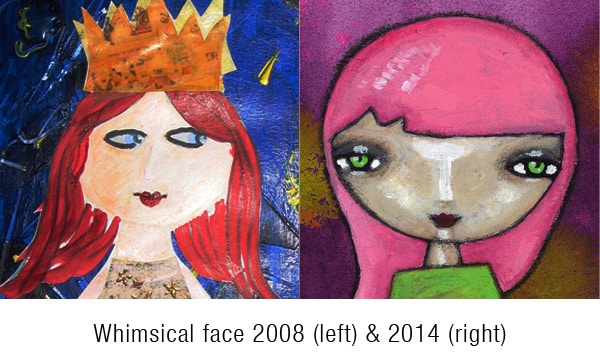Do you ever get so frustrated with your art that you just want to throw in the towel? Bin it? Give up?
I’m currently teaching in several places (Let’s Face It & Love Art Happy Life) and apart from the wonderful work that is being posted, people also sometimes express their frustration. Their annoyance at not getting it right or not drawing what they see in their mind’s eye. I read about people throwing their art in the bin or ripping it up.
My heart feels heavy when I see people being so hard on themselves!
I really understand that feeling, that annoyance and disgust at what was supporsed to be wonderful, but ended up severely lacking. I’ve never binned my art, but in a way I binned my creativity for years: by simply not creating for fear of creating something disappointing (again).
For me I want art to be something joyful, even if I recognise that it is sometimes a struggle (believe me, I struggle). Getting the balance right is actually a really big part of my wish for self-care and self-respect. Shooting yourself down actually adds another layer of suffering on top of the already existing disappointment of not liking something or something not working out right.
I feel so sad thinking about the fact that so many of you experience this, I want to share my tips for allowing art to be a more joyful experience.
1. Struggle. First of all, let’s just sit with the fact that we sometimes struggle. Life can be a struggle, art can be a struggle. And that is OK. Struggle is not something to be avoided at all cost or a marker of not doing it right. It just happens. Sometimes we struggle with something physical (e.g. art techniques) or emotional (e.g. confidence). If we interact with the struggle and face it it can help us actually get further on our journey. It helps us grow.
2. Letting Go Of The Outcome. I know I harp on a lot about letting go of the outcome *grins* but it’s just so relevant! The art you create simply is. It is not good, it is not bad, it just is. WHY do we want to throw it in the bin, or annihilate ourselves or rip it up? It’s about attaching an importance to it being something ELSE. As long as we’re focussed on wanting it to be anything other than what it is, we’re creating disappointment and suffering for ourselves.
3. Noticing. Being able to think critically and assess our work is a strength and can help us improve, but there is a difference between observing and criticising/annihilation. When you notice instead of judge, you’re simply observing what is. You can then absorb that knowledge in a positive way, rather than a judgy feel-bad-about-yourself-way. It’s the difference between “The eyes are all wrong! It’s ruined!” and noticing “The left eye is smaller than the right eye. I don’t enjoy the look that creates, next time I will try to pay more attention to getting the eyes the same size”.
4. Be Where You Are At. It’s so tough in this online world not to compare ourselves. I don’t know about you but my Facebook feed is filled with wonderful art from amazing artists all over the world. Everyone is doing their own thing and everyone is on their own path. Consuming dozens or hundreds of pictures of what other people are doing can really affect my confidence about what I am doing myself. I start comparing myself and wishing my art was ‘a little more like this’ or ‘a little less like that’. When I compare myself to others I’m treating myself so unfairly, because really I can’t compare myself to anyone other than myself! I’m Iris, I’ve been painting on and off since 2008 and consistently since 2013. I paint a few times a week. I tend to choose expression and play over technical skill and practice. I’ve not been to art school. I’ve followed some online classes. I love trying different materials. Etc etc etc (everyone has their own unique story). The art I’m making is a beautiful reflection of who I am at this point in time, and I am exactly where I need to be.
Say it with me now:
The art I’m making is a beautiful reflection of who I am at this point in time, and I am exactly where I need to be
I really hope that the above will give you some of the tools that have helped me get out of the critical judging way of approaching art and into a more accepting and joyful way of doing art.
If you have any tips I’d love to hear them, please leave a comment below!



















